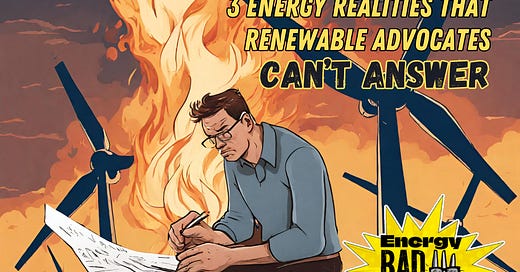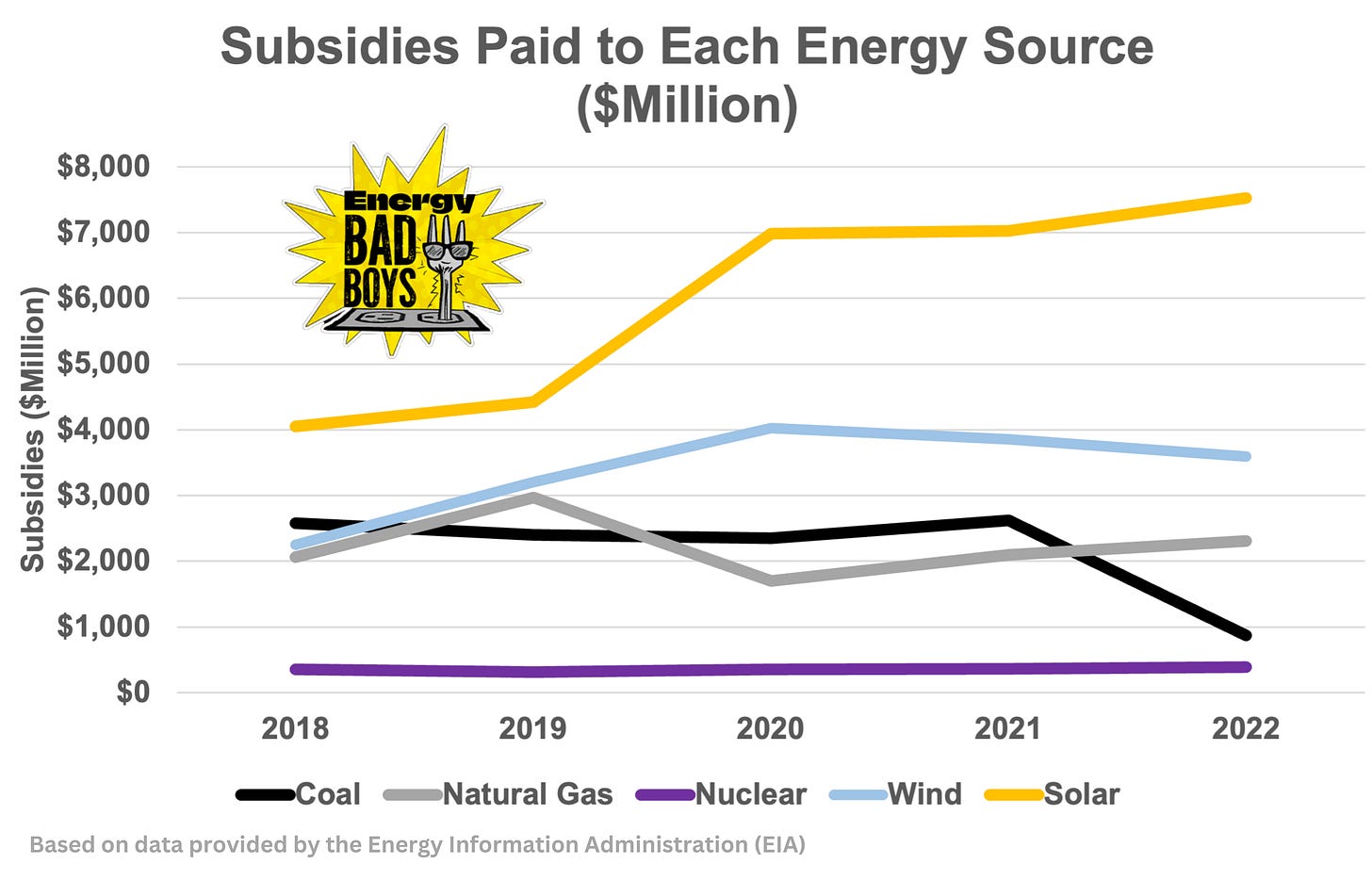3 Energy Realities That Renewable Advocates Can’t Answer
What renewable energy advocates never fully address about the failures of wind and solar
Renewable energy advocates like to stick to their talking points about wind and solar, but they never seem to address the elephant – or elephants – in the room when it comes to running a grid with weather-based, intermittent energy sources, such as not being able to survive without subsidies, causing massive price increases, and ultimately leading to blackouts.
When it comes to accounting for these issues, renewable advocates have mastered the lessons of Patches O’Houlihan.
However, just because advocates of wind and solar never address these concerns doesn’t mean they don’t exist.
Whether you’re in favor of an “above all approach,” indifferent about renewables, or aren’t in favor of them at all, the rest of us need to be aware of the realities and limitations of a grid with high levels of renewable generation. Plenty of examples exist that highlight these limitations and prompt serious reconsideration of the viability of the ongoing “energy transition” that currently favors intermittent renewables.
As long as the people who ignore these warnings keep calling the shots, it’s unlikely any real change will occur. In the hopes of highlighting the concerns side-stepped by renewable advocates, here are three energy realities that go unanswered.
1. Renewables can’t survive on their own
The renewable energy industry is a subsidy-based industry, as wind and solar are largely dependent on lucrative state and federal subsidies. However, renewable advocates justify these perpetual subsidies by claiming thermal generators receive more subsidies than wind and solar. This assertion is not based on reality, especially when considering subsidies paid per megawatt-hour (MWh) of energy produced.
The figures used to justify the claim above don’t just account for direct subsidies made to each energy source - they also include made-up figures that account for so-called unaddressed externalities that renewable advocates believe should be charged to thermal power plants that emit CO2. Some of these costs may be legitimate, but by definition, they aren’t subsidies.
https://www.forbes.com/sites/bjornlomborg/2020/01/17/the-imfs-huge-miscalculation-of-energy-subsidies/?sh=739b87364b42
Here is the Oxford definition of a subsidy:
[M]oney that is paid by a government or an organization to reduce the costs of services or of producing goods, so that the prices can be kept low.
A subsidy is a direct payment to an industry. It is not the absence of make-believe externality costs or penalties, but the heavily-quoted $7 trillion value for global fossil fuel subsidies from the International Monetary Fund (IMF) consists almost entirely of these made-up figures.
The truth about energy subsidies in the U.S. is easy to figure out. In fact, U.S. Energy Information Administration (EIA) data clearly show wind and solar generators absorb more subsidies than any other energy source in the country. In fact, without these subsidies, much of the renewable energy industry wouldn’t be able to survive - which is why it fights so vehemently to keep the subsidies alive.
The same cannot be said of thermal generators that thrive in normal markets but have trouble staying open in the face of massive price distortions caused by wind and solar. These price distortions also dissuade new generators from entering into service in areas where plants are more dependent upon market revenues.
When you look at direct federal subsidies paid to each industry - the only true meaning of a subsidy - it’s not even close, and the gap between thermal and renewable subsidies is growing, which you can see in the graph below.
When you compare subsidies paid per MWh of electricity produced, the gap grows even larger.
In 2022, wind and solar generators received three and eighteen times more subsidies per MWh, respectively, than natural gas, coal, and nuclear generators combined. Solar is the clear leader, receiving anywhere from $50 to $80 per MWh over the last five years, whereas wind is a distant second at $8 to $10 per MWh
Renewable energy sources like wind and solar are largely dependent on these subsidies, which have been ongoing for 30 years with no end in sight. We discuss this in our piece, Grassley v. The Grid, and it is something renewable advocates have no answer for. Instead, they make up their own figures regarding thermal subsidies to justify the continued existence of lucrative wind and solar payments that far exceed any other resource. The reality is that the industry would collapse without them.
2. Renewables increase the cost of electricity
Renewable advocates often claim that the adoption of more wind and solar will lead to lower electricity costs, but the opposite is true. In a previous Substack, we wrote in detail about how utility companies with the largest rate increase requests in the country admit the energy transition is a major reason behind increasing electricity prices for families and businesses. But the Energy Bad Boys are not the only ones reporting this.
Politico recently ran a story that highlights rising electricity costs in California, how they are due to the state’s climate policies, and how residents are becoming fed up with being asked to pony up more money for a failing energy transition. Indeed, the rising cost of electricity that stems from overbuilding tends to result in unhappy electricity ratepayers.
This is a major issue to discuss.
How is it that renewable advocates are so wrong about electricity cost increases stemming from massive wind and solar buildouts? The answer lies in relying on fundamentally flawed means of comparison between different electricity sources and the lack of accounting for the diminished value that wind and solar offer the grid compared to more reliable energy sources like coal, natural gas, and nuclear.
In other words, the framework they use for determining electricity prices is wrong because they don’t account for the full system costs of maintaining reliability.
Wind and solar are not the cheapest energy sources
Wind and solar advocates often claim these energy sources are the cheapest forms of electricity by citing Levelized Cost of Energy (LCOE) estimates created by Lazard.
However, Lazard’s LCOE estimates measure the cost of generating a megawatt-hour (MWh) of electricity from a new wind turbine or solar facility operating in optimal conditions; they do not account for the many hidden costs associated with building wind and solar.
These hidden costs consist of additional transmission, property tax, load balancing costs —which are the cost of backup power plants, whether natural gas or battery— and overbuilding and curtailment costs. Each of these costs is only necessary to incur because wind and solar are unreliable.1 Building new wind and solar also generates additional utility profits for IOUs, but Lazard’s LCOE estimates generally include a return on equity.
To have a fair comparison, these hidden costs must be accounted for, and the “All-In” LCOE™ of wind and solar must be compared to the cost of reliably serving a MWh of demand with the existing resources currently on the grid.
The Energy Bad Boys have compiled a database of costs per MWh for power plants owned by investor-owned utilities (IOUs) using FERC Form 1 data. These data almost always show that existing power plants are far less expensive than building new wind and solar facilities, especially when the full cost of maintaining reliability is included.
Existing power plants are almost always the lowest-cost sources of electricity on an electric grid because they have paid off their upfront capital costs —think of it like a mortgage— and are now fully depreciated. Replacing these facilities with less reliable and intermittent energy sources like wind and solar necessarily leads to higher electricity prices because it results in a less efficient energy system.
We calculated the hidden costs of wind and solar on a 100 percent carbon-free electric grid in Minnesota in our 2022 report and found that serving a MWh of load with new wind would cost $272 per MWh, and new solar would cost $472 per MWh, compared to $39.60, $31.45, and $46.52 per MWh for existing coal, natural gas, and nuclear power plants, respectively.
In other words, the statement that wind and solar are the cheapest energy sources can only be made if you use “creative accounting” methods that ignore the full cost of using them within an existing electric system without interruption, in addition to quoting the subsidized cost of electricity, not the true cost of generation. We plan on writing more about this topic in a series on the Levelized Cost of Intermittency.
Even with lucrative subsidies shifting some of the costs of the energy transition from ratepayers to taxpayers, which is simply picking the pockets of the same people from two different directions, the cost of electricity is still growing dramatically as a result of building unnecessary wind and solar plants.
Unfortunately, utility companies are more than happy to oblige the demands of renewable advocates to close down fully depreciated assets, despite how they could lead to affordable electricity rates for the families and businesses that paid for them. This is because utility companies earn a rate of return on every dollar they spend on building new power plants. Once fully depreciated, utilities no longer earn this rate of return but are only allowed to close and replace them with other sources if allowed by the state. The so-called “energy transition” has given them this excuse.
3. More wind and solar means more blackouts
Advocates of renewable energy also don’t want to account for one of the most damning facts about policies that favor wind and solar energy at the expense of dispatchable generators: that they have led to electricity blackouts in more than one region.
As more wind and solar generators are placed on a grid, it becomes more vulnerable to rolling blackouts because states or regions tend to neglect the importance of the dispatchable generators in their fleet to focus on wind and solar. These areas also tend to retire coal or nuclear plants in favor of less-dependable natural gas.
This is true whether this closure of reliable power plants is driven by state mandates for carbon-free electricity, like those enacted in California and Hawaii, or bad regulatory structures that only reward energy production, like the Electric Reliability Council of Texas (ERCOT) and Alberta.
For example, California has seen the amount of dispatchable power plant capacity in the state decline since 2013, even though total capacity has grown. This leaves fewer reliable power plants to shoulder demand when the sun goes to bed or the wind isn’t blowing. This situation resulted in rolling blackouts in 2020.
We have previously noted the same thing is happening in Texas, where the Electric Reliability Council of Texas (ERCOT) has relied solely on wind and solar capacity to meet a 30 GW increase in peak demand since 1999, which you can see in the graph below.
You don’t need to be a rocket scientist to recognize these patterns. There’s a reason the North American Energy Reliability Corporation (NERC), Federal Energy Regulatory Commission (FERC), and several Reliability Transmission Organizations (RTOs) have all issued warnings about the growing reliability threat of blackouts stemming from prematurely retiring dispatchable power plants and becoming overly-reliant upon wind and solar.
Those who claim that failures at existing thermal plants caused these blackouts do not account for these decades-long trends of building primarily intermittent energy sources to meet growth in demand and the disastrous results the policies involved have had on dispatchable generators.
Maybe we should stop playing stupid games if we don’t want to win the associated prizes.
Conclusion
Despite claiming to be ardent followers of “tHe ScIEncE,” wind and solar advocates live in their own universe of alternative facts that deny the basic physics and economics of the electric grid. Hopefully, this piece is useful for you the next time a wind or solar stan is arguing with you in the comments section.
Clicking like and sharing will #trigger a wind and solar fan, and subscribe for more from Energy Bad Boys.
Here’s what we’ve been reading this week:
Repowering will represent nearly half of all new wind capacity in 2024: Enverus by Utility Dive;
Democrats pushed climate action. Then utility bills skyrocketed in Politico;
Out Of Transmission Revisited by
Lazard’s latest assessment included a “Cost of Firming Intermittency,” but while a step in the right direction, this only accounts for a portion of the full cost by only requiring four hours of battery storage in California and using gas-peaking resources in other regions of the country.















I live in Virginia and thanks to the Virginia Clean Energy Act we are facing the same issues. Virginia does not have good wind resources, so growth of renewables is based on building 24 GW of solar. Virginia is proud of its rural countryside but no one has thought through the impact of 24 GW of utility solar farms. At 5 - 10 acres per MW of nameplate capacity these solar farms would cover 120,000 to 240,000 acres of land. That's one to two counties of Virginia completely covered in solar farms, feeder grids and long distance power lines from rural Virginia to Northern Virginia where the power is needed.
Of course nuclear is capped, and the dispatchable power of coal and NaturalGas, which generates two thirds of Virginia’s power has to be shut down.
Of course 24 GW of solar doesn’t meet Virginia’s need for power, so it is planning to import 11 GW of coal fired power from West Virginia- until that gets shut down by the Inflation Reduction Act.
Eventually you run out of other people’s electricity.
And as you say all this comes at a cost, with prices planning to rise by 66% by 2030 and double by 2035.
When will this nonsense stop.?
Joining that California/Hawaii club are a few fridgid weather states, Minnesota, Michigan, New York, and possibly Massachusetts. Winter blackouts in these states is not simply an inconvenience. No one in California or Hawaii is freezing to death without power. These far North states are a different matter.